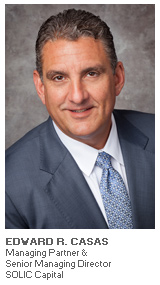.jpg)
In January of this year, commercial finance professionals learned that SOLIC Capital had put the final pieces of its platform in place with the transition of Navigant Capital’s Investment Banking and Restructuring Group into its affiliate, SOLIC Capital Advisors. According to SOLIC’s press release, the aim was to an create an integrated platform suited to provide principal investing solutions, distressed asset management, investment banking and restructuring advisory services in an efficient and industry-leading solution to middle-market special situations.
ABL Advisor recently spent time with Dr. Edward Casas who stands at the helm of the SOLIC organization. As a physician and a decorated veteran of the Desert Shield/Desert Storm Gulf War operations, Casas’ path to the financial advisory space is, needless to say, rather unique. Armed with a joint degree in both medicine and business, Casas went on to complete a Masters in Public Health. Upon leaving the military, he joined a Fortune 500 company spin-off called Caremark. That move was the start of a 25-year plus career in “cradle to grave” corporate rehabilitations.
In the following interview, Casas explains the transition from Navigant to SOLIC in greater detail which, he notes, is more about evolution than revolution.

ABL Advisor: Ed, please give our readers a sense of what the recent announcement regarding the formation of SOLIC Capital Advisors means for both your organization, its clients and for the industry as a whole.
Ed Casas: To begin with, SOLIC is just an evolution of a platform of professionals who have been working together on average for 15 years. Many of your readers are most likely aware of this fact. To give you a sense of how far we reach back, we originally began as Caremark International in the early 1990s. From there we formed Casas Benjamin White and built that up for seven years, at which point we were acquired by Navigant. We were at Navigant Capital Advisors for ten years and we really wanted to get back into the principal investing side of the business.
As I said, this really is an evolution and late last year, the entire staff of Navigant Capital Advisors joined the business segment of financial advisory services at SOLIC. This transition was blessed from the onset … it wasn’t hostile and there was no acrimony. Rather, this was a pre-agreed upon transition that occurred over two years when we initiated the principal and distressed asset components of SOLIC’s business in 2012. The intention to migrate Navigant Capital Advisors and in turn, initiate the financial advisory component had been in place all along.
ABL Advisor: What would you say was the impetus to integrate the three business segments under the SOLIC umbrella?
Casas: As you know, we’ve seen the capital markets change dramatically over several cycles. The advent of securitizations migrated lending from money center bank syndicates to money center bank agented deals with CLOs, CDOs and the emergence of BDCs, commercial finance companies and other players.
With the credit driven recession in 2008, many of the money center banks retracted; CDOs and CLOs became very difficult to issue and liquidity was measured. All this fueled greater growth into the BDC type structures and if you look at where the capital has been deployed as the market has rebounded, it is primarily at the upper end of the middle market … bulge bracket, high quality names. But there are a good many 2006 and 2007 credits that were restructured that don’t have access to capital. That’s one aspect of the market trends.
Another trend is that in the middle market, single sourced multi-tranche lenders are becoming a growing phenomenon. That used to be segregated and money center banks wanted the top in the cap stack. Depending on where we were in the cycle, the banks would go 3.5 to 4.5 times leverage on a cash-flow basis. Asset-based lending as the alternative to cash flow was disciplined as well and a “don’t get mixed up with the lower element” mentality prevailed.
In time, we witnessed the emergence of mezzanine lenders and the popularity of second lien lenders. The commercial finance companies and the BDCs emerged with charters to be able to provide the necessary capital requirements with risk-adjusted yields at every tranche … even down into equity or preferred equity. When you have that kind of simplicity as it relates to institutional holders in your capital stack, what emerges is a need and a benefit to provide single set solutions.
ABL Advisor: Could you relate these trends to the integration of the restructuring team at SOLIC?
Casas: Sure. Traditionally, financial advisory, crisis management or fiduciary oversight, and investment banking services are segmented in the marketplace. You have accounting oriented professionals who conduct financial assessments, operating specialists who do interim management and investment bankers that do the sell side. If you’re going through a workout, you go through a transition of advisors, which apart from inefficiencies and lack of continuity, is expensive with each advisor typically having disparate incentives. Now, change the picture. You have a unified multi-tranche lender; one institution is the senior secured lender, has a sub-debt piece and puts in a piece of preferred equity and fully capitalizes the balance sheet of a middle-market company. That company runs into trouble and it’s a sponsored deal and the sponsor doesn’t want to put in new money. What do you do?
Continued on Page 2...